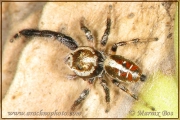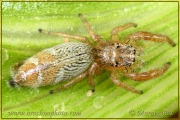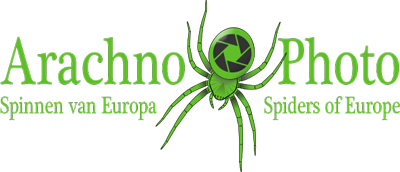The Salticidae are small to medium in size and have a rectangular forehead. On the front of their heads, they have four large eyes that allow them to see better than spiders of other spider families. The retinas of the two eyes in the middle can move forwards and backwards in order to adjust the focus. Probably they are sensitive to polarized light as well as colours. The other four eyes do not have this ability and can only detect motion. All eight eyes together give the spider a nearly continuous 360° field of view, which in any case can detect movement. The Salticidae use their good eyesight mainly to hunt, whereby they approach their prey to a few centimeters and then jump and grab it with their often thickened front legs. They are very curious and sometimes almost completely raise their carapace to observe an object, such as a human or a camera. They show themselves mainly in warm and sunny weather. In gloomy weather conditions and during winter they hide in a silken retreat.
The different species can be distinguished from each other by differences in their markings and build. In Europe about 340 species occur.
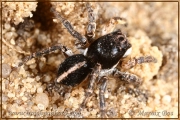
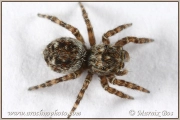
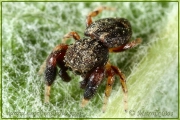
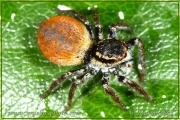
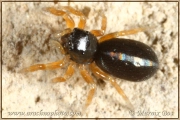
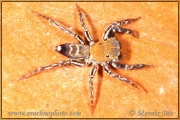
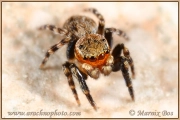
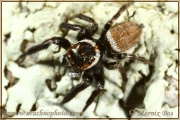
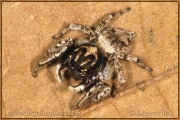
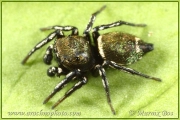
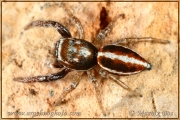
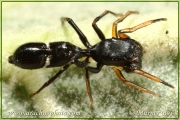
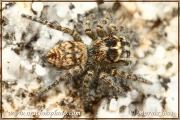
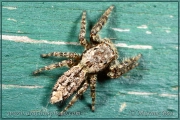
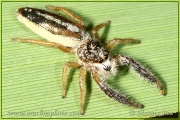
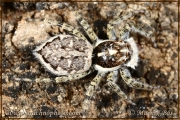
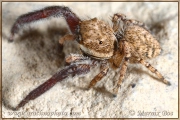
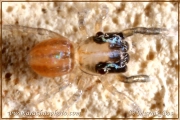
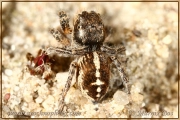
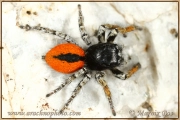
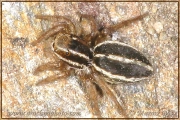
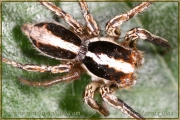
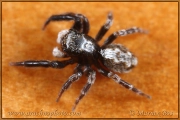
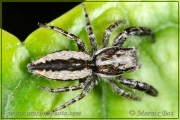
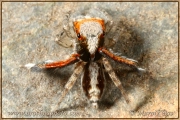
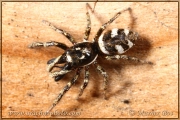
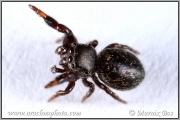
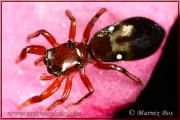
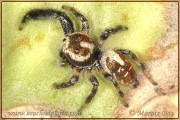
Genus Aelurillus
These spiders are built solidly and compact, with a fairly high forehead. The males are very dark coloured. The colour of the females is often sandy. They live in a hot, dry and rocky area or in open places with low vegetation. They mainly hunt ants.
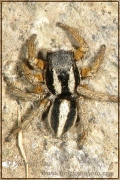
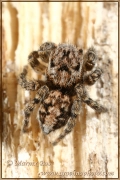
Genus Attulus
These are small compact spiders. They are brown or greyish with a pattern of light or white hairs. The sexes are different in appearance. The hind legs are noticeably longer than the other. Their habitat ranges from sand dunes to wet or stony areas and high altitudes in mountains, sometimes even above the tree line.
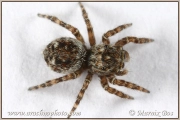
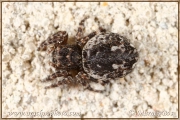
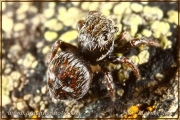
Genus Ballus
Ballus is a small, solidly built spider with a posture that seems a bit timid. They are often dark brown. The legs are pale with dark sprial-shaped markings, so that they seem to be constricted. The front legs are thickened in the male spider. They live on shrubs and deciduous trees.
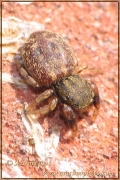
Genus Carrhotus
The spiders of this genus are solidly built and occur on sunny bushes in the warmer parts of Europe. The sexes can be completely different in colour and pattern.
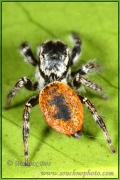
Genus Chalcoscirtus
These are small, shiny spiders (2-3 mm.) with a typical median groove on the carapace. Males have a glossy scutum on their abdomen. They live under stones and rubble on the ground.
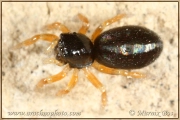
Genus Cyrba
These are small to medium, sometimes very colourful, spiders. It is a primitive genus, which is reflected in the use of webs, the large posterior eyes and the presence of the excretory organs on the femora of the males. Other, less primitive Salticidae, have lost these organs in evolution. Cyrba occurs in a rocky, stony area and mainly hunts other spiders, but sometimes catches insects as well.
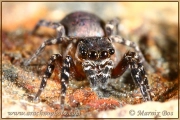
Genus Euophrys and Pseudeuophrys
These two genera are strongly related and are mentioned together in literature. The spiders are quite small, with a maximum of 5 mm. Males have front legs which are often darker than the rest of the spider and are sometimes iridescent. In addition, the males of some species have light hairs on the palps. They live under stones or in low vegetation.
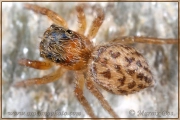
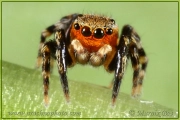
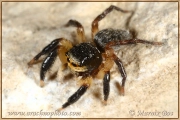
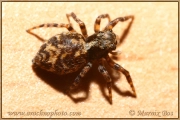
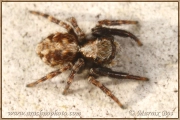
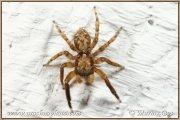
Genus Evarcha
The spiders of this genus are of medium size and compact. They have clear markings, making the different species well distinguishable. This is especially the case in males. The females make their egg sacs in rolled dry leaves or in bundled plant residues.
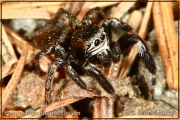
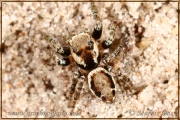
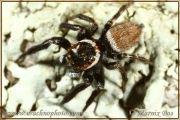
Genus Habrocestum
Unfortunately, there is very little information available about these spiders. In addition to the six species in Europe, there are many species in Africa and Asia.
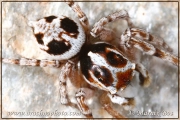
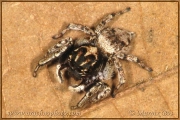
Genus Heliophanus
These eye-catching spiders have a very dark body with a strong red, copper or green metallic shine. The legs are often much lighter in colour and in the females the palps are often yellow. Usually they have a thin white line on the front of the abdomen. They live in low vegetation, but in sunny weather they can also be found a little higher.
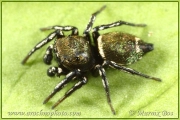
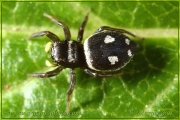
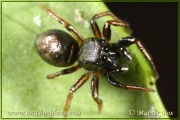
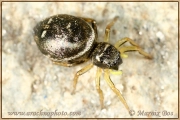
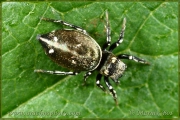
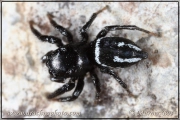
Genus Icius and Pseudicius
The spiders of these genera are closely related. The build of the spiders is elongated and especially in males pair of legs I is clearly longer and thicker than the other legs. They somewhat resemble the Marpissa -species, but are half the size. They occur in forest areas between leaves and moss and on bark.
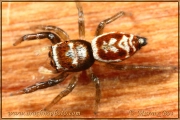
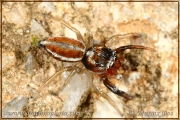
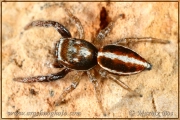
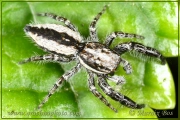
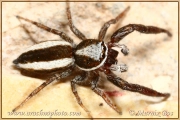
Genus Leptorchestes
The spiders of this genus are sometimes called ant spiders. In their appearance and behavior, they resemble ants, so at first glance they do not stand out between them when they are hunting and running around. The spiders have a remarkably long petiolus between the carapace and the abdomen and the legs are pretty thin. The abdomen also has a constriction in the centre, making it appear that the body consists of three parts.
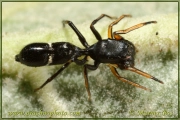
Genus Macaroeris
This genus consists of only one species in southern Europe. The spider sits there mostly on warm, sunny places in bushes and branches. The name Macaroeris is derived from Macaronesia, where most other species of this genus occur.
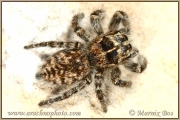
Genus Marpissa
These are fairly large spiders with a flat carapace and an elongated abdomen. Pair of legs I is clearly longer and thicker than the other legs. The males use these legs during the mating dance: they put them in the air, moving them to and fro, prior to touching the female.
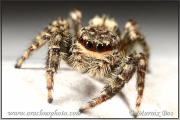
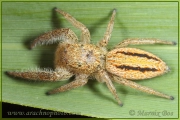
Genus Mendoza
Unfortunately there is very little information available about these spiders. Since 1999 the genus is represented in Europe, because then the species M. canestrinii was moved from the genus Marpissa to this genus.
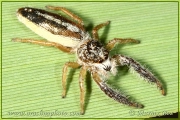
Genus Menemerus
These spiders are about the same size as the Marpissa-species, but slightly more angular in the shoulders. They usually occur in warmer areas on sunny walls and stones, sometimes in homes as well. Males have hairy white palps. It is the most common jumping spider in the warmer regions of Europe.
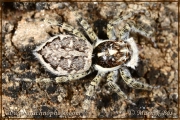
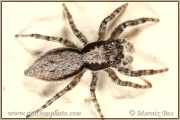
Genus Neaetha
Unfortunately there is very little information available about these spiders. The authors observed that the male, which sat on a stone, began making digging movements on the surface of the stone with his huge front legs. This way he gathered gravel with which he subsequently covered his silken retreat. As a result, the spider was no longer visible in its retreat. It is not known whether all species of the genus show this particular behavior or just the species N. membrosa.
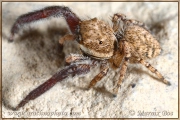
Genus Neon
The Neon spiders are among the smallest (1.4 – 3 mm.) of the Salticidae. The different species are very similar to each other. The head is often brightly coloured with large black areas around the relatively large eyes. Also, the male palp is relatively large compared to the size of the spider. In contrast to the other Salticids, which love sun light, Neon prefers darker environments. They prey on the ground in the undergrowth and in low vegetation. They can also be found under stones.
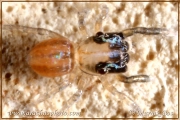
Genus Pellenes
The spiders of this genus are often black-brown coloured with white markings on the abdomen, sometimes with red elements as well. They display a remarkable preference for empty snail shells, which they use as a retreat to hibernate and to lay and guard their egg sac. Sometimes the snail’s shell is even suspended from a plant with silk threads, a bit above the ground.
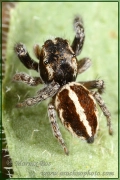
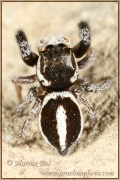
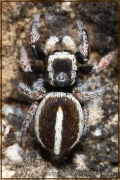
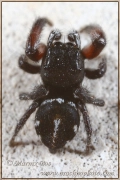
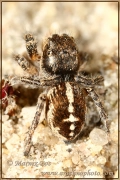
Genus Philaeus
The males of this genus are strikingly coloured and both sexes have a variable pattern. They occur in warm, often stony areas, mainly in southern Europe. Sometimes they can be found on walls in villages and at high altitudes in mountains as well. They are heat-loving animals that keep hidden in their retreats under stones during bad weather conditions.
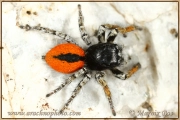
Genus Phlegra
The spiders of this genus have got a high forehead as well as the species of Aelurillus, but they are more elongated and less solidly built. They occur in warm, stony or sandy areas with little vegetation.
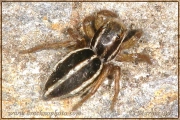
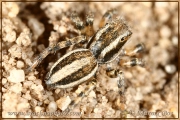
Genus Plexippus
The spiders of Plexippus have a elongated shape. Males do somewhat resemble males of the genera Icius and Pseudicius. Special about these spiders is that they build a tubular retreat coated on the outside with a dense layer of sticky silk. Passing insects get stuck in it, after which the spider captures and eats them.
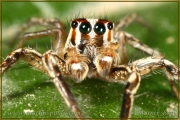
Genus Saitis
The spiders of this genus predominantly occur in Australia, but in the Mediterranean area some species can be found as well. They mainly live in and around houses, sometimes on rocks and stone plateaus. Pair of legs III of the male is elongated and brightly coloured. He uses these legs for the peculiar mating dance, whereby he puts his legs in the air and makes waving movements to impress the female.
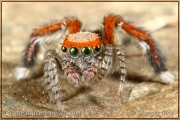
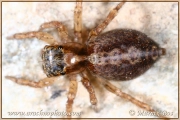
Genus Salticus
The spiders of this genus have a black and white striped appearance, making them easily recognizable. They are active in warm sunny weather and live on walls and trees. They often catch prey larger than themselves, and can be seen walking around with it. In bad weather, they remain in a suitable hole. Males have greatly enlarged chelicerae which they use in conflicts with rival males and during courtship.
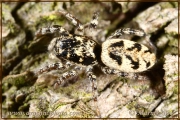
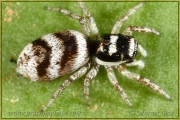
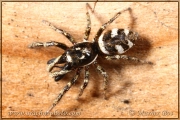
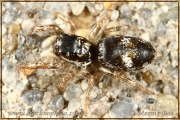
Genus Sibianor
These spiders are solidly built with a variable colour and markings. The front legs in males are strongly thickened. They often scurry around in the undergrowth and low vegetation, looking for prey.
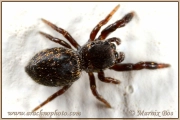
Genus Synageles
Synageles is a genus of ant-mimic spiders. They are quite small (about 4 mm.) and closely resemble ants in behavior and appearance. They walk around busily and move their abdomen rhythmically up and down. In addition, they lift pair of legs I, so it seems like they have antennae. In the male, the abdomen is slightly constricted in the middle.
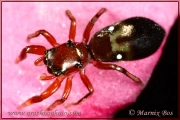
Genus Thyene
These colourful spiders mainly occur in Africa and parts of Asia. In Europe, two species can be found in the Mediterranean area.
